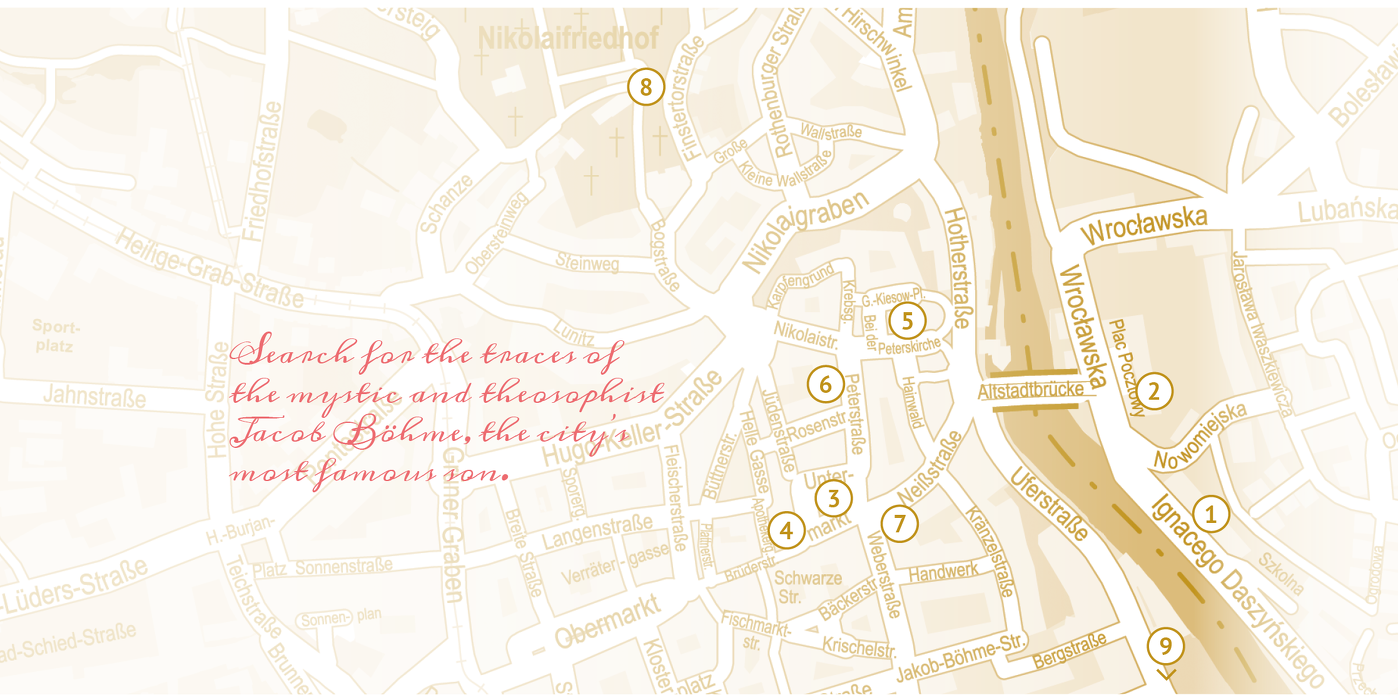

„At the age of 25, once again seized by the Divine Light“, thus said the poet, friend and first biographer of Jacob Böhme about the great vision which the mystic perceived in Görlitz and which was meant to determine his whole life.
Thirty years of Jacob Böhme’s life are closely connected with the city of Görlitz, covering the beginnings of his work as a shoemaker as well as the longstanding period of his creative activity until his burial. Visiting Görlitz is to enjoy an exciting journey through history and to discover numerous traces of Jacob Böhme’s life: places of his life, of his inspiration, and of the dispute between him and the church authorities who considered his enthusiastic belief a provocation. Those, who appreciate Böhme‘s work, will simply love to be so close to the personal history and the soul of the great mystic while visiting these places in the city on the Neisse River.



Three places of manual and spiritual Creation
Böhme’s first house in the suburbs on the Neisse River (Neißevorstadt): On April 24, 1599, the shoemaker Böhme, being a master of his craft, registered himself as a citizen of Görlitz, and thus, committed himself to get married and to buy a house within half a year. After his marriage on May 10, he purchased a dwelling house on August 21, which was located in former Ravens Lane (Rabengasse) at the eastern banks of the river, today Zgorzelec, Poland. The house had been severely damaged and was rebuilt in 1870/1871. It accommodates a Jacob Böhme exhibition today.
His second residence: This house purchased by Jacob Böhme on June 22, 1610, fell victim to the construction of the Old Town Bridge in 1905. A memorial plaque recalls that Jacob Böhme lived here and wrote several of his works in this house, among them was “Aurora”, his first work. From this place, according to his last words, he entered “into paradise” on November 17, 1624.
Lower Market (Untermarkt) cobbler bench: On April 24, 1599, Jacob Böhme acquired the burgher rights of Görlitz and spent altogether the respectable amount of 600 Görlitz Marks on the burgher rights, a cobbler bench and a dwelling house including furnishing. For thirteen years, he sold shoes here, manufactured by his own hands.

Competition Law and the Struggle for Freedom of Expression
Historical flights of stairs at the City Hall: Jacob Böhme was summoned several times, so he had to enter the Town Hall, walking up the famous Renaissance stairways, passing the column of Lady Justice. Until 1623, those hearings were related to his work and to the numerous disputes with the tanners. Later, it was his manuscripts that started to attract the attention of Justice and Church.
Courtyard of the Town Hall/Court Oriel: On July 26, 1613, Jacob Böhme appeared in front of the incumbent Mayor Scultetus, after the high priest Gregor Richter had reported him to the authorities because of his manuscript “Die Morgenröte im Aufgang“ or “Aurora” (The rising of Dawn” or “Aurora”). On March 26, 1624, after having published several of his works, he had to defend himself against the accusation of having infringed an earlier prohibition to write. Both times, Jacob Böhme benefitted from a certain leniency of the public authorities and of councillor Scultetus; being himself a humanist and a follower of Paracelsus, the latter did not want to support the strict line of the clergy.

Between Heaven and Earth, Belief and Science
Main Parish Church of St. Peter and Paul: This gothic church, colloquially called Peter’s Church, used to be both the place of important events in Jacob Böhme’s life as well as his life-long spiritual and religious centre. It was here, that he married Katharina Kuntzschmann, daughter of butcher, on May 10, 1599, and it was here, that his four sons were baptised. But it was also in St. Peter’s Church, that the dispute with the clergy became obvious. The trigger was a sermon by the Lutheran priest Gregor Richter bashing the theosophist’s manuscripts and initiating the long-term conflict between Böhme and the Church as an institution. Even though there is only the wrought-iron baptismal lattice in the northwestern corner of the church, cast in 1617 and renewed in 1696, which dates back to that time, but Saxony’s biggest and oldest church of this type is definately worth a visit.
Number 4 Peter’s Street (Peterstraße 4): Bartholomäus Scultetus, who used to live in number 4 Peter’s Street, played an important role in Jacob Böhme’s life. In his position as a Mayor, he dealt with the conflict between Böhme and the church with a degree of leniency. As a revolutionary astronomer, he influenced the spiritual-creative process of Jacob Böhme and can be regarded as one of his supporters. Today, his dwelling house presents one of the city’s most beautiful accessible inner courtyards.

On foot or at the desk, Görlitz takes you to back to the times of Jacob Böhme
Upperlusatian Library of Sciences: Together with the International Jacob Böhme Association residing in the same place, the library is considered to be a unique centre of research. Researchers have a comprehensive collection of Böhme literature at their disposal, including numerous hand-written documents and early prints. To catch just a glance into the reading room is a highlight for every visitor!
// Jacob Böhme in the Upperlusation Library
Jacob Böhme’s tomb in St. Nicholas‘ Cemetery (Nikolaifriedhof): The conflict between Böhme and the Church continued beyond his death. At first, the funeral was rejected, then, the buriel cross donated by Böhme’s friends was destroyed. A dignified commemoration came about only at the beginning of the 19th century after the Upperlusatian Library, and later American Böhme followers, had donated three tomb slabs.
// St. Nicholas‘ Cemetery
Jacob Böhme Monument: How did he look like in reality? “His outward physical appearance was withering and ill-looking, he was of small stature, had a low forehead, high temples, a bent nose, grey and almost sky-blue, sparkly eyes... he had a fine, short beard...“, says the only available description given by Böhme’s former biographer. The monument in the Park of Peace is just one of the numerous interpretations!
Walking in the tracks of Jacob Böhme in Görlitz